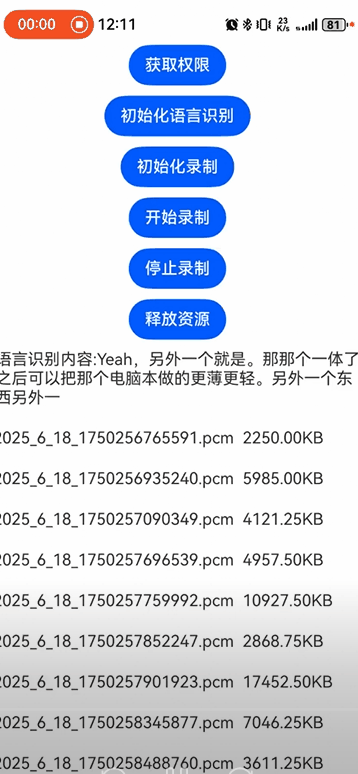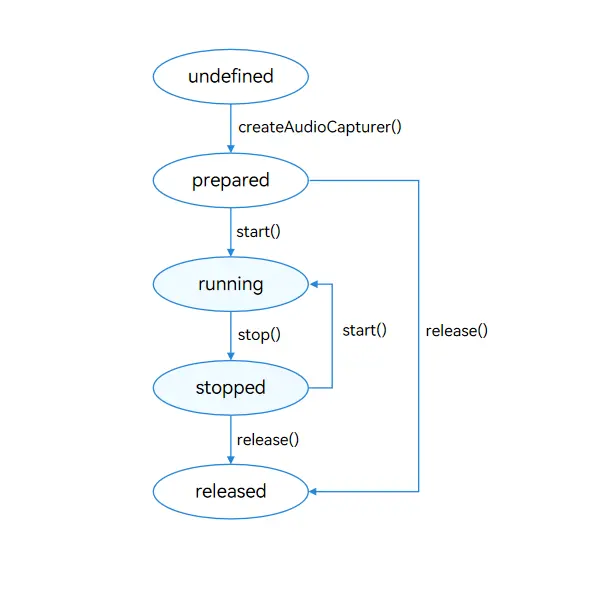鸿蒙 Next 使用 AudioCapturer 实现音频录制和 AI 语言转文字
作者:auhgnixgnahz
- 2025-06-25 北京
本文字数:3250 字
阅读完需:约 11 分钟
上篇介绍了使用 AVRecorder 录制音频,这篇记录一下使用 AudioCapturer 实现录制音频,并且实现在录制的同时,使用 AI 实现语音转文字的功能。
效果演示:

录制实现步骤:
1.配置音频采集参数 AudioCapturerOptions:AudioStreamInfo 音频流信息和 AudioCapturerInfo 音频采集器信息
let audioStreamInfo: audio.AudioStreamInfo = { samplingRate: audio.AudioSamplingRate.SAMPLE_RATE_48000, // 采样率。 channels: audio.AudioChannel.CHANNEL_2, // 通道。 sampleFormat: audio.AudioSampleFormat.SAMPLE_FORMAT_S16LE, // 采样格式。 encodingType: audio.AudioEncodingType.ENCODING_TYPE_RAW // 编码格式。};let audioCapturerInfo: audio.AudioCapturerInfo = { source: audio.SourceType.SOURCE_TYPE_MIC, // 音源类型:Mic音频源。根据业务场景配置,参考SourceType。 capturerFlags: 0 // 音频采集器标志。};let audioCapturerOptions: audio.AudioCapturerOptions = { streamInfo: audioStreamInfo, capturerInfo: audioCapturerInfo};
复制代码
2.创建 AudioCapturer 实例,并添加回调函数
audio.createAudioCapturer(audioCapturerOptions, (err, data) => { if (err) { console.error(`Invoke createAudioCapturer failed, code is ${err.code}, message is ${err.message}`); } else { console.info('Invoke createAudioCapturer succeeded.'); this.audioCapturer = capturer; //实例化成功赋值 } });//新建音频文件this.fileName = new Date().getFullYear()+'_'+(new Date().getMonth()+1)+'_'+new Date().getDate()+'_'+new Date().getTime()+'.pcm';this.audioFile = fs.openSync((context.filesDir +'/'+ this.fileName), fs.OpenMode.READ_WRITE | fs.OpenMode.CREATE);//监听音频数据读取回调事件audioCapturer.on('readData', (buffer: ArrayBuffer) => { let options: Options = { offset: this.bufferSize, length: buffer.byteLength } if (this.audioFile !== undefined) fs.writeSync(this.audioFile!.fd, buffer, options); this.bufferSize += buffer.byteLength;}) //监听状态变化事件(当AudioCapturer状态发生变化时触发)audioCapturer.on('stateChange', (state: audio.AudioState) => { this.currentState = state});
复制代码
AudioState 状态如下:
3.开始录制、结束录制、释放资源
AudioCapturer 状态变化示意图

语言识别实现步骤:
语音识别(SpeechRecognizer)将一段中文音频信息(中文、中文语境下的英文;短语音模式不超过 60s,长语音模式不超过 8h)转换为文本,音频信息可以为 pcm 音频文件或者实时语音。
1.调用 createEngine 方法,对引擎进行初始化
// 设置创建引擎参数 let extraParam: Record<string, object> = { "locate": "CN", //区域信息 当前仅支持“CN” "recognizerMode": "long", //语言模式 当前支持“short“和“long” "sysGeneralLexicon":['鸿蒙',] //支持配置热词提高识别率 }; let initParamsInfo: speechRecognizer.CreateEngineParams = { language: 'zh-CN', //语种,当前仅支持“zh-CN”中文 online: 1, //1为离线,当前仅支持离线模式 extraParams: extraParam };
// 调用createEngine方法 speechRecognizer.createEngine(initParamsInfo, (err: BusinessError, speechRecognitionEngine: speechRecognizer.SpeechRecognitionEngine) => { if (!err) { console.info('Succeeded in creating engine.'); // 接收创建引擎的实例 this.asrEngine = speechRecognitionEngine; this.setListener() } else { // 无法创建引擎时返回错误码1002200001,原因:语种不支持、模式不支持、初始化超时、资源不存在等导致创建引擎失败 // 无法创建引擎时返回错误码1002200006,原因:引擎正在忙碌中,一般多个应用同时调用语音识别引擎时触发 // 无法创建引擎时返回错误码1002200008,原因:引擎已被销毁 console.info( `Failed to create engine. Code: ${err.code}, message: ${err.message}.`); } });</string, object>复制代码
2.初始化成功之后,设置监听回调
// 创建回调对象 let setListener: speechRecognizer.RecognitionListener = { // 开始识别成功回调 onStart(sessionId: string, eventMessage: string) { console.info( `onStart, sessionId: ${sessionId} eventMessage: ${eventMessage}`); }, // 事件回调 onEvent(sessionId: string, eventCode: number, eventMessage: string) { console.info( `onEvent, sessionId: ${sessionId} eventCode: ${eventCode} eventMessage: ${eventMessage}`); }, // 识别结果回调,包括中间结果和最终结果 onResult(sessionId: string, result: speechRecognizer.SpeechRecognitionResult) { console.info( `onResult, sessionId: ${sessionId} sessionId: ${JSON.stringify(result)}`); context.eventHub.emit('updateMessage', result.result,result.isFinal); }, // 识别完成回调 onComplete(sessionId: string, eventMessage: string) { console.info( `onComplete, sessionId: ${sessionId} eventMessage: ${eventMessage}`); }, // 错误回调,错误码通过本方法返回 // 返回错误码1002200002,开始识别失败,重复启动startListening方法时触发 // 更多错误码请参考错误码参考 onError(sessionId: string, errorCode: number, errorMessage: string) { // console.info( `onError, sessionId: ${sessionId} errorCode: ${errorCode} errorMessage: ${errorMessage}`); }, } // 设置回调 this.asrEngine!.setListener(setListener);
复制代码
识别结果在 onResult 回调中返回,SpeechRecognitionResult 信息如下:
3.设置麦克风转文字功能开始识别的相关参数
//音频配置信息 let audioParam: speechRecognizer.AudioInfo = { audioType: 'pcm', //音频类型。 当前仅支持“pcm” sampleRate: 16000, //音频的采样率。 当前仅支持16000采样率。 soundChannel: 1, //音频返回的通道数信息 当前仅支持通道1 sampleBit: 16 //音频返回的采样位数 当前仅支持16位 } //启动语音识别的相关参数 let extraParam: Record<string, object> = { "recognitionMode": 0, //0:实时录音识别(需应用开启录音权限 1:实时音频转文字识别,开启此模式时需要额外调用writeAudio方法,传入待识别音频流 "vadBegin": 2000, "vadEnd": 3000, "maxAudioDuration": 8 * 60 * 60 * 1000, //最大支持音频时长 //短语音模式支持范围[20000-60000],单位ms,不传参时默认20000ms。 //长语音模式支持范围[20000 - 8 * 60 * 60 * 1000],单位ms } let recognizerParams: speechRecognizer.StartParams = { sessionId: this.sessionId, audioInfo: audioParam, extraParams: extraParam }</string, object>复制代码
4.开始识别
console.info( 'startListening start');this.speechResult=''this.speechCurrent=''this.asrEngine!.startListening(recognizerParams);
复制代码
5.传入音频流,在 audioCapturer,'readData’回调函数中将麦克风获取的音频流传给语言识别引擎
let uint8Array: Uint8Array = new Uint8Array(buffer);// 语言识别在运行状态下 写入音频流if (this.asrEngine!==undefined&&this.currentState==2)this.asrEngine!.writeAudio(this.sessionId, uint8Array)
复制代码
6.结束录制之后停止语音识别
关注私信,获取完整源码
划线
评论
复制
发布于: 刚刚阅读数: 2
版权声明: 本文为 InfoQ 作者【auhgnixgnahz】的原创文章。
原文链接:【http://xie.infoq.cn/article/be587ecca750d958b138da75c】。文章转载请联系作者。
auhgnixgnahz
关注
还未添加个人签名 2018-07-10 加入
欢迎关注:HarmonyOS开发笔记










评论